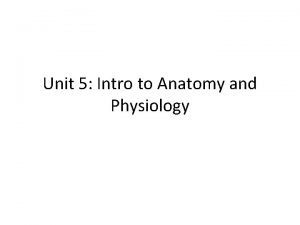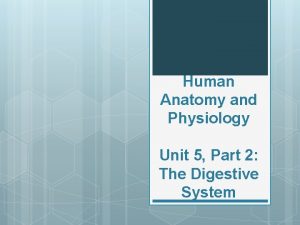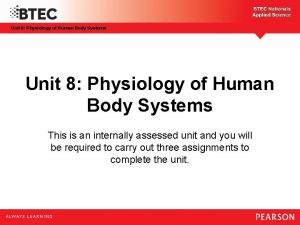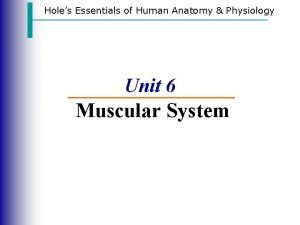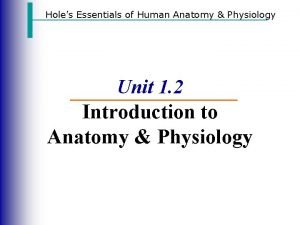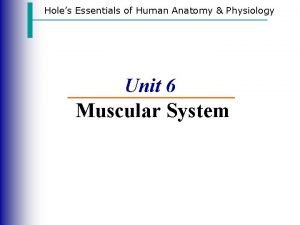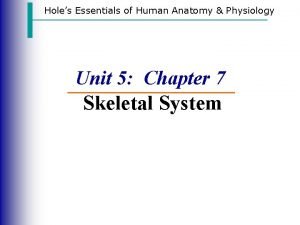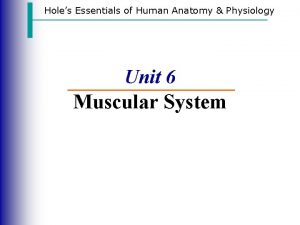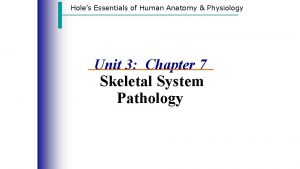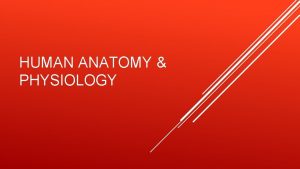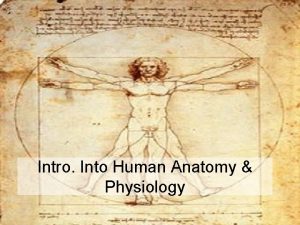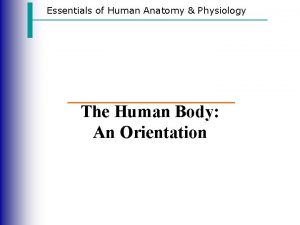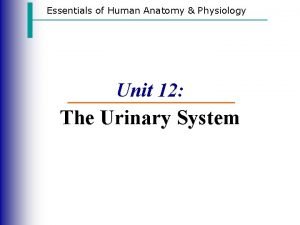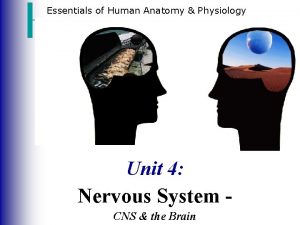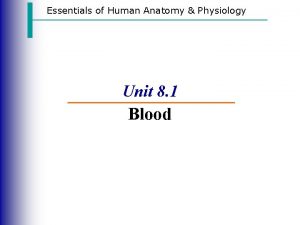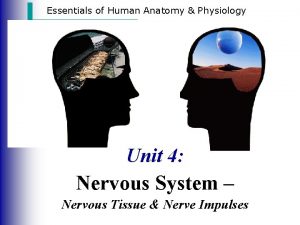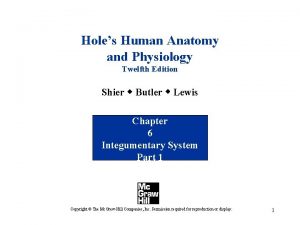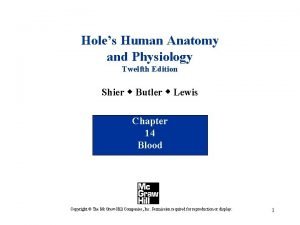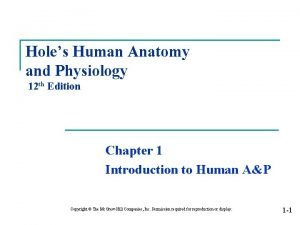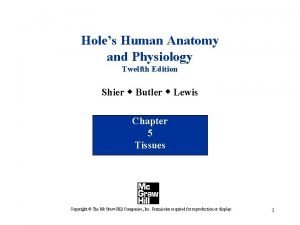Holes Essentials of Human Anatomy Physiology Unit 3



























- Slides: 27

Hole’s Essentials of Human Anatomy & Physiology Unit 3: Chapter 7 Skeletal System Part I

Classification of Bones • Bones are classified according to their shape (5)

Classification of Bones · Long bones · Typically longer than wide · Have a shaft with heads at both ends · Contain mostly compact bone · Examples: · Femur (thigh bone), · humerus (arm bone), · all the bones of the limbs (except wrist and ankle)

Classification of Bones · Short bones · Generally cube-shape · Contain mostly spongy bone · Examples: Carpals (wrist), tarsals (ankle)

Classification of Bones · Flat bones · Thin layers of compact bone around a layer of spongy bone · Usually curved · Examples: Skull, ribs, sternum (breastbone), scapula (shoulder blade)

Classification of Bones · Irregular bones · Irregular shape · Do not fit into other bone classification categories · Example: Vertebrae, hip, auditory ossicles

Classification of Bones · Sesamoid (round) bones · Small and nodular · Embedded within tendons adjacent to joints · Example: kneecap (patella)

Parts of a Long Bone · Diaphysis = shaft · Consists of a central medullary cavity filled with marrow · Surrounded by a thick collar of compact bone · Epiphyses = expanded ends · 1 -proximal & 1 -distal · Consists mainly of spongy bone · Surrounded by thin layer of compact bone · Epiphyseal plate = · area of hyaline (articular) cartilage causing lengthwise growth of a long bone at junction of epiphyses and diaphysis · Epiphyseal line = · remnant of epiphyseal plate

Epiphyseal line vs Epiphyseal plate

Bone Structure – Gross Anatomy · Periosteum = Tough, outer dense white fibrous connective tissue protective covering of the diaphysis · Richly supplied with blood vessels, nerves · Serves as an osteogenic layer contains osteoblasts & osteoclasts, cells that form and repair bone tissue · Serves as an insertion for tendons and ligaments · Endosteum = Thin, inner lining of the medullary cavity · Contains osteoblast & osteoclast cells · Medullary cavity = Hollowed central region · Houses marrow

Bone Structure – Gross Anatomy · Articular cartilage = Pad of hyaline cartilage covering the external surface of the epiphyses · Decreases surface friction · Osteoarthritis – thinning of articular cartilage · Sharpey’s fibers = Secures periosteum to underlying bone · Nutrient arteries · Supply bone cells with nutrients · Enter bone thru nutrient foramen in compact bone

4. 5. 1. 6. 7. 2. 8. 9. 10. 3.

Hyaline Cartilage Connective Tissue · D: · Most common cartilage · Avascular = no healing · Composed of: · Chondrocytes (in lacunae) · Abundant collagen fibers · Amorphous rubbery matrix · L: · Found at ends of bones, in joints, soft part of nose, larynx, rings of cartilage in trachea, costal cartilage · Entire embryonic skeleton is hyaline cartilage · F: · Support

Microscopic Structure - Tissue · Bones are classified according to their types (2) · Compact bone · homogeneous, mainly in long bones · continuous extracellular matrix w/o space · dense, concentric circles of osseous tissue · site of red blood cell formation in children · Spongy bone · heterogeneous, mainly in short bones · small needle-like pieces of bone · many open spaces · site of red blood cell formation in adults · lightens bone

Histology of Compact Bone – Micro Anatomy · Osteon (Haversian System) · Structural unit of bone · Elongated cylinders cemented together to form the long axis of bone · Components of an osteon: · Osteocytes – spider shaped bone cells · Lacunae – chambers/cavities containing osteocytes · Lamellae – concentric matrix of collagen and calcium salts · Central canal (Haversian canal) – center of osteon containing blood vessels and nerves · Communicating canals within compact bone · Canaliculi – connect the lacunae together · Volkman canals (Perforating canals) – connect blood vessels and nerve supply of adjacentral canals together · Perpendicular to the central canal

Histology of Compact Bone – Micro Anatomy

Histology of Spongy Bone – Micro Anatomy · · Consist of poorly organized trabeculae Trabeculae are small needle-like pieces of bone Open space exists between trabeculae Nourished by diffusion from nearby central canals

Histology of Bone · Organic component (35%) – CELLS · Osteoprogenitor cells: -- Derived from mesenchyme (a loosely organized, mainly mesodermal embryonic tissue that develops into connective and skeletal tissues, including blood and lymph ); Can undergo mitosis and become osteoblasts · Osteoblasts -- Form bone matrix by secreting collagen; Cannot undergo mitosis BUILDERS!!! · Osteocytes -- Mature bone cells derived from osteoblasts; Principle bone cell; Cannot undergo mitosis; Maintain daily cellular activities · Osteoclasts -- Function in bone reabsorption (destroy and clear away bone matrix; Important in development, growth, maintenance and repair of bone · · Osteoid -- Primarily collagen, which give bone its tensile strength and flexibility Inorganic component (65%) – MINERAL SALTS · Hydroxyapatite, which is primarily calcium phosphate, gives bone its hardness and compression strength


Functions of Bone Tissue · Support of the body tissues · Legs & pelvis support body’s weight · Atlas supports the skull · Protection of underlying organs · Skull – protects the brain, eyes, ears · Rib cage & shoulder girdle – protects heart and lungs · Pelvic girdle – protects lower abdominal organs and internal reproductive organs · Movement · Skeletal muscles attached to bones by tendons serve to move bones · Muscles use bones to work in opposition to cause movement

Functions of Bone Tissue · Mineral Homeostasis · Bones store many minerals including: · Calcium salts, mainly calcium phosphate · Magnesium, sodium, potassium, carbonate ions · Harmful minerals stored: · Lead, radium, strontium · Energy storage · Yellow marrow in the shaft of long bones · Serves as an important chemical energy storage (fat) · Can convert back to red marrow if blood cells are needed and revert back to yellow marrow when there is a blood cell surplus

Functions of Bone Tissue · Hematopoiesis · Blood cell formation · All blood cells are formed in the red marrow of certain bones · Children: mostly in medullary cavities of long bones · Adults: spongy bones of skull, ribs, sternum, clavicles, vertebrae, hip bones

Skeletal system microanatomy Whaddya know?

1. What is the process of red blood cell formation? • hematopoiesis 2. What is the type of cell the undergoes mitosis and creates osteoblasts? • Osteoprogenitor 3. What type of marrow produces blood cells? • red marrow 4. Where is the marrow found in children? Adults? Medullary cavity; spongy bone 5. What are the two types of bone? • Spongy; compact 6. What are the four shapes of bone? And give an example of each. • Short carpals, tarsals, patella • Long humerus, femur, radius, ulna, tibia, fibula, metacarpals, metatarsals, phalanges • Flat ribs, sternum, cranial and facial bones • Irregular hip bones, vertebra 7. What is the inorganic compound that makes up bone? What does this provide the bone with? 1. Hydroxyapatite; compression strength

Articular cartilage 8 Epiphyseal plate 15 9 Epiphysis Spongy 10 bone Compact 11 bone Medullary 12 cavity Periosteum 13 14 Endosteum Diaphysis 16

Compact bone 17 Spongy bone 18 Periosteum 19 Haversian Canal 20

Lacunae Haversian canal Canaliculi Lamella
 Holes essential of human anatomy and physiology
Holes essential of human anatomy and physiology Holes anatomy and physiology chapter 1
Holes anatomy and physiology chapter 1 Human anatomy and physiology seventh edition marieb
Human anatomy and physiology seventh edition marieb Chapter 1 introduction to human anatomy and physiology
Chapter 1 introduction to human anatomy and physiology Anterior posterior distal proximal
Anterior posterior distal proximal Chapter 2 human reproductive anatomy and physiology
Chapter 2 human reproductive anatomy and physiology Human anatomy and physiology 10th edition
Human anatomy and physiology 10th edition Anatomy and physiology edition 9
Anatomy and physiology edition 9 Unit 26 animal anatomy physiology and nutrition
Unit 26 animal anatomy physiology and nutrition Anatomy and physiology unit 7 cardiovascular system
Anatomy and physiology unit 7 cardiovascular system Unit 26 animal anatomy physiology and nutrition
Unit 26 animal anatomy physiology and nutrition Horizontal anatomical plane
Horizontal anatomical plane Unit 5 anatomy and physiology
Unit 5 anatomy and physiology Unit 8: physiology of human body systems assignment 1
Unit 8: physiology of human body systems assignment 1 Lower respiratory tract
Lower respiratory tract Tattoo anatomy and physiology
Tattoo anatomy and physiology Anatomy science olympiad
Anatomy science olympiad Crown plants examples
Crown plants examples Anatomy and physiology bones
Anatomy and physiology bones Stomach ulcer anatomy
Stomach ulcer anatomy Liver anatomy
Liver anatomy Hypogastric region
Hypogastric region Epigastric region
Epigastric region The blood anatomy and physiology
The blood anatomy and physiology Chapter 14 anatomy and physiology
Chapter 14 anatomy and physiology Http://anatomy and physiology
Http://anatomy and physiology Physiology of appendicitis
Physiology of appendicitis Aohs foundations of anatomy and physiology 1
Aohs foundations of anatomy and physiology 1











